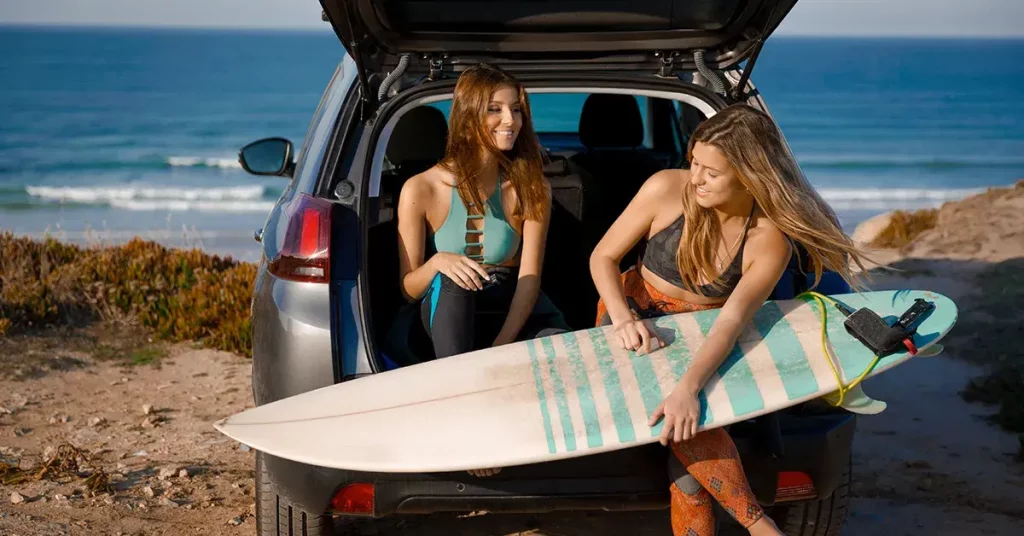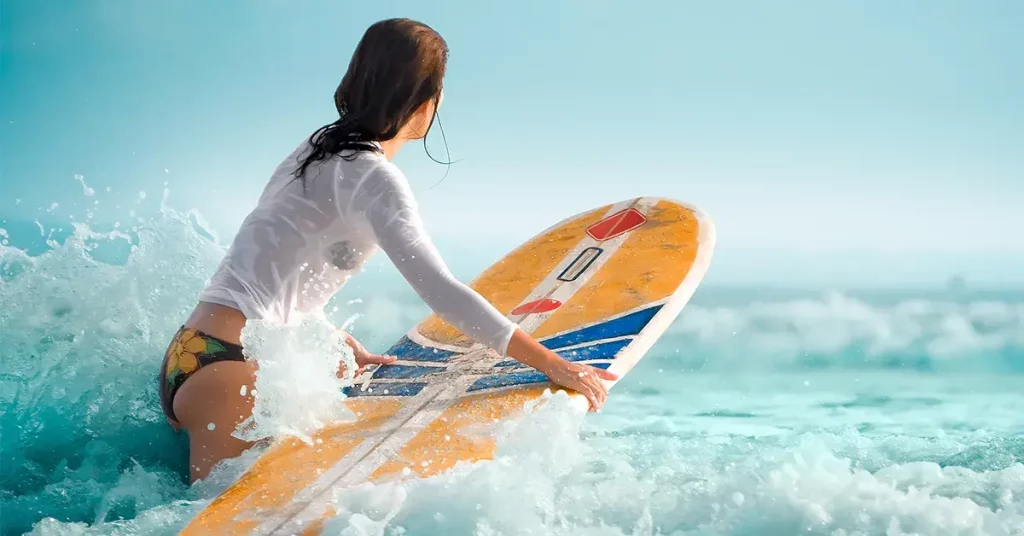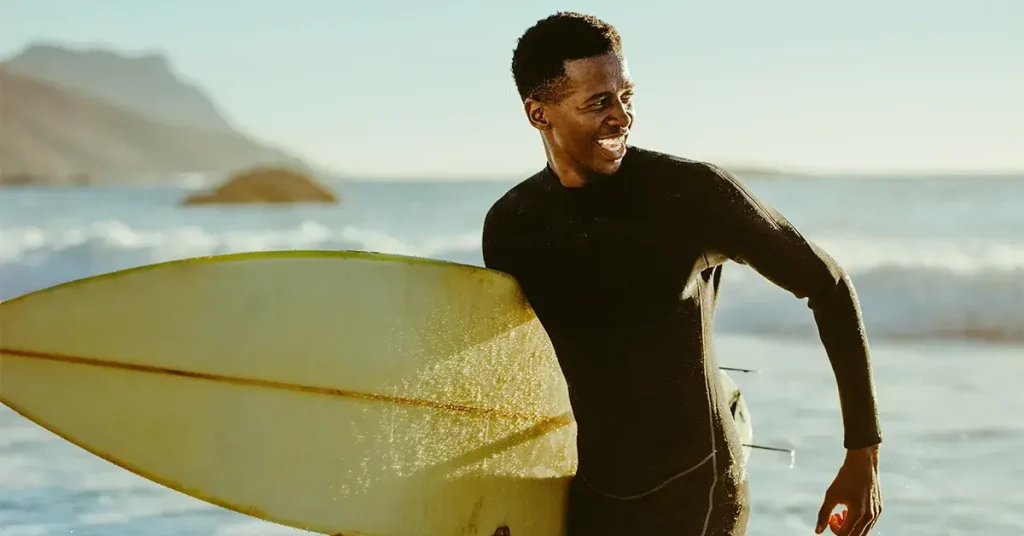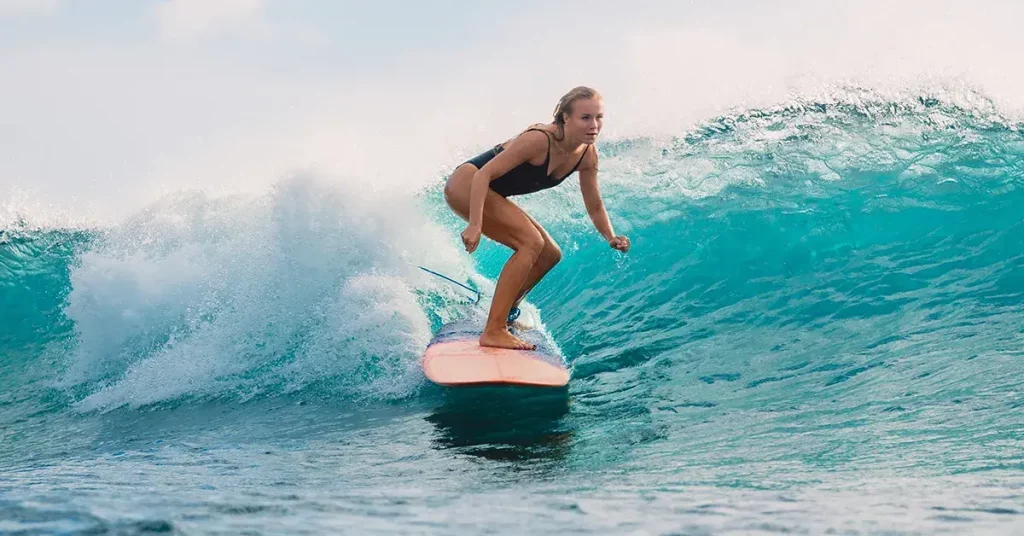Like any new hobby, surfing demands initial start-up costs. But exactly how much does surfing cost to get started? Here’s an essential gear list to give you an idea of what your initial investment might be.
Essential Gear Needed for Surfing

Once you have the basic equipment necessary to start surfing, the good news is that the vast ocean is all you require after that.
How much surfing costs depends on a lot of factors, such as if you will buy new or used surfing equipment or if you decide to invest in surf lessons.
Surfing is not particularly difficult to learn so if you live within proximity to a beach ideal for surfing, you can purchase a surfboard and a wetsuit and get started almost immediately.
Surfboard

$100 used – $1000 new
The price of a surfboard might range anywhere from $100 to $1,000 or even higher. Getting started, you don’t need to invest too much in a surfboard. A quick look on Craigslist or a local surf shop will show you plenty of good quality surfboards with tons of life left in them and with an affordable price tag.
As your skill level increases, you can justify spending more on a surfboard. On the other hand, if this is a sport you’re serious about, you may want to go straight for a brand new board that you’ll use for years.
When it comes to selecting a surfboard, larger boards are universally preferable. It is recommended that you purchase a surfboard that is 8 feet long, but the ideal length is somewhere around 9 feet 6 inches. You can check out this guide we’ve put together that shows you what size and type of surfboard to buy.
Wetsuits

$125 used – $350 new
Depending on where you’re surfing, a neoprene wetsuit is the next piece of gear you’ll need to invest in. Even though the sun may be shining and the summer air is hot, that ocean water can be brutally cold. A wetsuit is designed to keep you warm while still being able to move easily on your board.
There are different kinds of wetsuits to choose from– once again, depending on the water temperature you’ll be surfing in.
If you’re unsure of what wetsuit to wear during a particular season, a local surf shop is a great resource to find out which kind of wetsuit you’ll need.
Full Hooded Wetsuit
A full hooded wetsuit is appropriate for winter surfing or water that is considered frigid. It covers your entire body except for your hands and feet. As the name states, it even has a hood with a little visor– perfect for keeping your head toasty and those sparkly sun rays from hurting your eyes.
Full Wetsuit
A full wetsuit covers your entire body except for your hands, feet and head. This is best when you’re late spring surfing or the water is considered cold.
Spring Suit
A spring suit is a full wetsuit on top but with the neoprene stopping just under your butt. Your arms and torso are fully covered but your legs and feet are exposed. This is a typical suit for California summers or for “cool” water. It’s perfect for us surfers who get cold easily but the air temp is warm enough that when we’re on our boards, we don’t need that extra length of neoprene.
Short Arm Steamer
This wetsuit is similar to a spring suit but the arms are not full length. Instead, they are more of a short-sleeved wetsuit. Also, the legs are covered down to the knee. Just like the spring suit, this suit is great for those warm summer days with cool summer water.
Wetsuit Jacket or Vest
These are just as they are named. They’re great to wear with your bathing suit being the remaining fabric that covers your body. They’re appropriate for warm or tropical waters.
No Wetsuit and Rash Guard with Board Shorts
The option to not wear a wetsuit is always available. No matter where you surf, there will always be a local surfer wearing nothing but swim trunks or a bikini.
In this case, you could try wearing a rash guard instead of a wetsuit. For women, you’ll likely need boardshorts over your bathing suit bottoms. When you lay on the board, the tops of your thighs will rub on the board. Going surfing without covering the tops of your legs can prove to be painful when they’re rubbed raw and in the salty seawater.
Going with no wetsuit and instead, using a rashguard and board shorts will definitely be less expensive, but you may find yourself so cold, you won’t be able to enjoy that new board of yours.
Trying on a wetsuit
If it’s your first time shopping for a wetsuit, we strongly suggest going to a physical store rather than ordering it online. An excellent wetsuit requires an almost perfect fit, and it will take a bit of time to find one that fits just right. Expect to size up in wetsuits– don’t get discouraged if the wetsuit that fits you best is a size or two larger than you assumed it would be.
Surfing Lessons

From $10 per hour
Not everyone will need to take surfing lessons from a local guide or shop. If you have a friend or family member that knows how to surf, you’re lucky– your surf lessons might cost you nothing more than a burrito and a beer at the end of the day!
If you do opt to pay for lessons, the price of a surfing lesson can change quite a little depending on the duration of the surf lesson, the location of the surf lesson, the number of people in the group and the type of instruction you take.
In both the United States and Canada, the price of a group surfing session ranges approximately between $60 and $80 per hour of instruction.
However, surfing lessons that last for one to two hours often cost between $10 and $20 per person. In more crowded or vacation locales, the hourly rate can be anywhere from $20 to $70. Even though some surf shops offer free surf lessons, they do so to encourage customers to purchase one of their boards or other items first.
The typical time for the surfing class is between one and two hours. You may receive either a half-day or a full day of education, but your chosen lesson determines this. You may be required to bring your wetsuit and surfboard to the lesson.
There are additional circumstances in which the price may include the rental of the surfboard and the wetsuit; however, the cost of these packages might reach several hundred dollars. Some surfers offset their surf lessons cost by joining a surf school. If you decide to go the surf school route, adhere strictly to the lessons so the learning process can be smooth.
Surf Wax

$3 – $6
When first learning to surf, investing in some affordable surf wax is necessary, it prevents you from sliding off your board, which, if it has no wax on it, will become as slippery as an oil slick as soon as it gets wet, knocking you off as soon as you hit the first wave. Trying to surf without wax can seriously hurt you.
Surf wax is inexpensive and although it is used each time you surf, you may not need to use the same amount each surf session.
It’s important to note that just like wetsuits, there are different types of wax to use depending on the water temp you’re surfing in and two different layers of wax to use on your board.
Wax Layers
Base coat
The base coat is just as it sounds. This wax goes down first, on the deck of your clean board. It is a harder wax than the top coat and it is meant to hold that top coat down.
Top Coat
The top coat goes on over the base coat and you can choose between traditional or sticky wax. If you’re a new surfer– a grom– you’ll likely want to invest in some quality sticky wax. The sticky wax creates a rough surface that your wet feet can grip. It’s applied only to the deck area on your board where your feet go.
Wax Types for Water Temps
Because surf wax is a very soft wax, it’s important to use the right kind for certain temperatures of water. You don’t want to use a cool water wax for warm waters and vice versa.
Tropical
Tropical wax is used in water temps 75 degrees and above.
Warm
Wax meant for water of 58 – 75 degrees.
Cool
Surf wax for water temps of 58 – 68 degrees
Cold
Used for water temps 60 degrees or below. Brrr!
Surfboard Fins

From $50
Fins are a crucial component of a surfboard because they enable the rider to maintain control of the board while navigating waves and moving through the water.
There are different kinds of fins you can attach to a surfboard, but most surfboards come with fins already attached. You may not need to purchase these. Typically, custom boards come without fins. If you do need to purchase fins, the surf shop staff will be able to direct you to the right kind for you.
When purchasing a used item, check the ad listing to see if the fins are included, and contact the seller if you don’t find any mention of them. If attaching fins is something you find yourself doing, you use a little Allen wrench or key to screw them onto your board.
Surf Leash

From $30
A surf leash keeps you and your surfboard together during your surf sesh. You’ll find a small metal bar embedded into the end of the deck of your board– this is where you loop your surf leash on. At the other end of the leash is a velcro band. This band wraps around your ankle.
Your surf leash keeps your board from getting away from you or washing up on shore miles away when you fall into the water. But, it also gives you the security of knowing that when you fall into the water, you have a floating platform nearby to grab onto. Granted, your surfboard should not replace a life vest if you aren’t a good swimmer, but it does help to give you a place to pull yourself out of the water and stay on top of the waves.
A leash is a piece of safety equipment; therefore, purchasing an inexpensive, subpar leash can result in dangerous situations. It’s best to find a new, quality leash with a strap that won’t break or velcro that doesn’t stay together.
Waterproof Key Holder

$20
If you are driving to the beach, you will also require a watertight key holder.
Many robbers are aware that surfers hide their car keys under or around their vehicles, which means that they could very well be observing you as you hide your stuff.
In addition to this, almost all car or truck keys manufactured nowadays have electrical components. If you do not protect them with a case or holder that is completely watertight, they are likely to become inoperable after only a single-use.
Wrap Up
Surfing is no different than any other sport when it comes to investing in some gear to get started. Take the time to shop around for boards as this is the most crucial piece of equipment for the sport. Whether you buy a new or used piece of equipment is up to you. However, some surf gear is worth it to buy new.
Regardless, once you start surfing, you won’t want to stop. It’s an addictive sport with a relaxed culture that supports good vibes and embraces nature. It doesn’t get any better than that.




